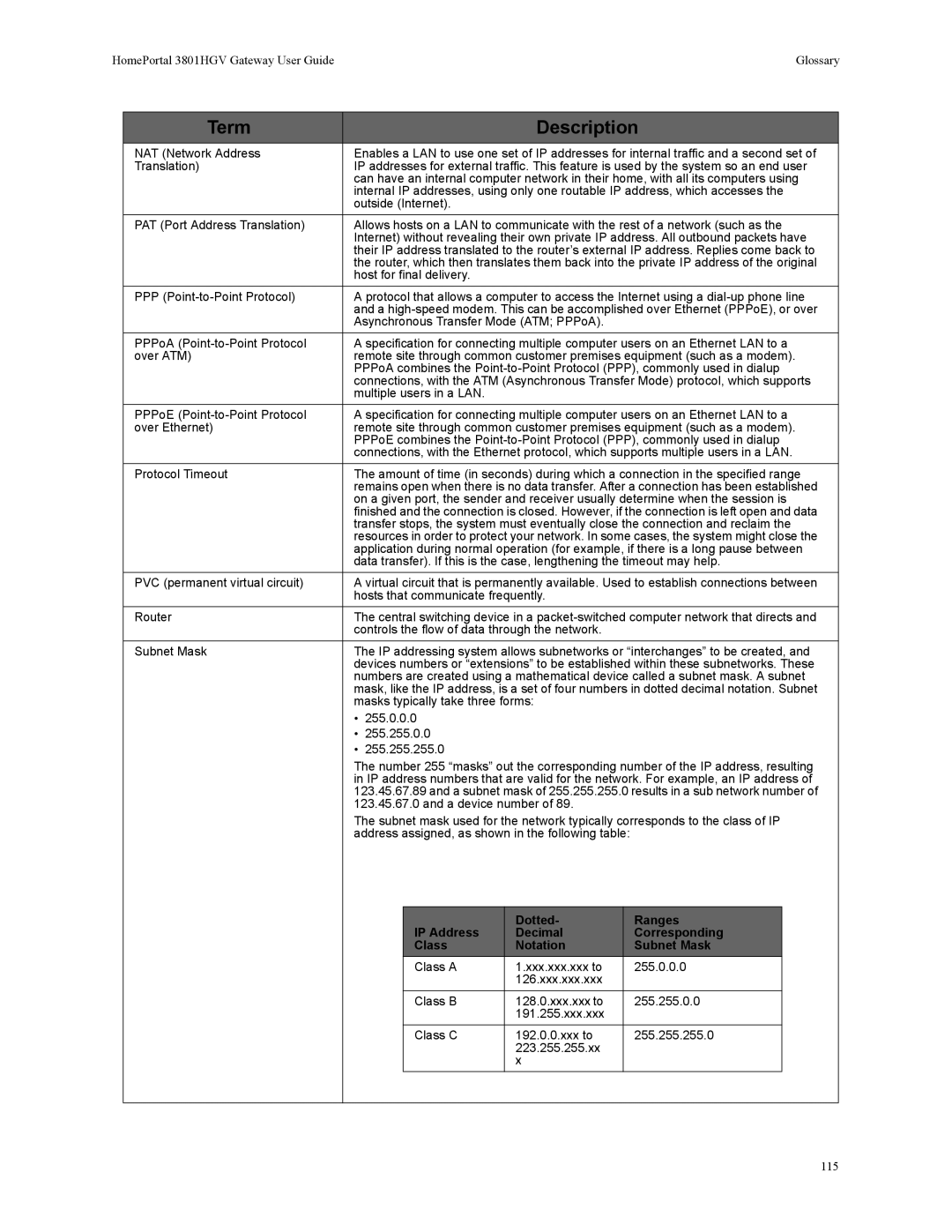
HomePortal 3801HGV Gateway User Guide | Glossary |
Term |
| Description |
NAT (Network Address | Enables a LAN to use one set of IP addresses for internal traffic and a second set of | |
Translation) | IP addresses for external traffic. This feature is used by the system so an end user | |
| can have an internal computer network in their home, with all its computers using | |
| internal IP addresses, using only one routable IP address, which accesses the | |
| outside (Internet). | |
PAT (Port Address Translation) | Allows hosts on a LAN to communicate with the rest of a network (such as the | |
| Internet) without revealing their own private IP address. All outbound packets have | |
| their IP address translated to the router’s external IP address. Replies come back to | |
| the router, which then translates them back into the private IP address of the original | |
| host for final delivery. | |
PPP | A protocol that allows a computer to access the Internet using a | |
| and a | |
| Asynchronous Transfer Mode (ATM; PPPoA). | |
PPPoA | A specification for connecting multiple computer users on an Ethernet LAN to a | |
over ATM) | remote site through common customer premises equipment (such as a modem). | |
| PPPoA combines the | |
| connections, with the ATM (Asynchronous Transfer Mode) protocol, which supports | |
| multiple users in a LAN. | |
PPPoE | A specification for connecting multiple computer users on an Ethernet LAN to a | |
over Ethernet) | remote site through common customer premises equipment (such as a modem). | |
| PPPoE combines the | |
| connections, with the Ethernet protocol, which supports multiple users in a LAN. | |
Protocol Timeout | The amount of time (in seconds) during which a connection in the specified range | |
| remains open when there is no data transfer. After a connection has been established | |
| on a given port, the sender and receiver usually determine when the session is | |
| finished and the connection is closed. However, if the connection is left open and data | |
| transfer stops, the system must eventually close the connection and reclaim the | |
| resources in order to protect your network. In some cases, the system might close the | |
| application during normal operation (for example, if there is a long pause between | |
| data transfer). If this is the case, lengthening the timeout may help. | |
PVC (permanent virtual circuit) | A virtual circuit that is permanently available. Used to establish connections between | |
| hosts that communicate frequently. | |
Router | The central switching device in a | |
| controls the flow of data through the network. | |
Subnet Mask | The IP addressing system allows subnetworks or “interchanges” to be created, and | |
| devices numbers or “extensions” to be established within these subnetworks. These | |
| numbers are created using a mathematical device called a subnet mask. A subnet | |
| mask, like the IP address, is a set of four numbers in dotted decimal notation. Subnet | |
| masks typically take three forms: | |
| • | 255.0.0.0 |
| • | 255.255.0.0 |
| • | 255.255.255.0 |
The number 255 “masks” out the corresponding number of the IP address, resulting in IP address numbers that are valid for the network. For example, an IP address of
123.45.67.89and a subnet mask of 255.255.255.0 results in a sub network number of
123.45.67.0and a device number of 89.
The subnet mask used for the network typically corresponds to the class of IP address assigned, as shown in the following table:
IP Address | Dotted- | Ranges |
Decimal | Corresponding | |
Class | Notation | Subnet Mask |
Class A | 1.xxx.xxx.xxx to | 255.0.0.0 |
| 126.xxx.xxx.xxx |
|
Class B | 128.0.xxx.xxx to | 255.255.0.0 |
| 191.255.xxx.xxx |
|
Class C | 192.0.0.xxx to | 255.255.255.0 |
| 223.255.255.xx |
|
| x |
|
